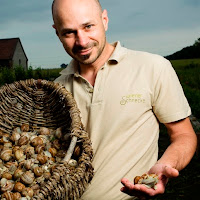Executive summar by darmansjah
Andreas Gugumuck stands alongside his snail yard on the
outskirts of Vienna and begins to tell me about the long, almost lost,
tradition of snail farming in this city. The yard is the size of a basketball
court, and sprinkled with half-chomped soup vegetables.
Centuries ago, Andreas explain, snails were highly valued as
a source of protein among the poor. By the turn of the 20th century,
Vienna had become a world capital in snail production. Those halcyon days
vanished, however, and snail farming had virtually died out until Andreas
decided to pack in his IT job a couple of years back and revive the tradition.
Today he produces two types of snails for Austria’s tables – Helix pomatia, a
variety common in Central Europe that has a gamey taste, and Helix aspersa, the
variety most often eaten in France.
‘The pomatia emerge from the ground in late March and begin
mating,’ he explains, casting an eye about. In a stroke of luck, we discover a
threesome. ‘The act usually lasts about 12 hours. They lay about 40 or 50 eggs
in the earth emerge about 30 baby snails.’
His snails, however, tell only half the story. Andreas also
produces a snail caviar by harvesting their pearly white eggs. I tried it at
Aubergine, one of Vienna’s upmarket restaurants. It is served with
Kalbsbeuschel, a Viennese veal offal entrée based on sliced lung. It’s
surprisingly good, with no hint of awkward slime. For more information please
log on : www.wienerschnecke.at/fuerhrungen.html


No comments:
Post a Comment